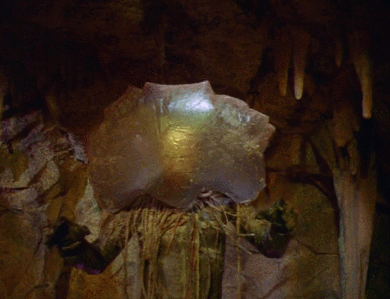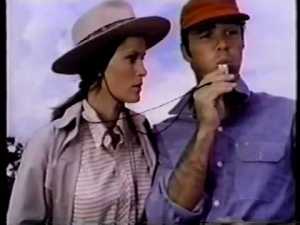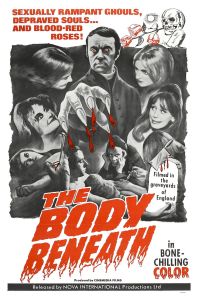He Came from the Swamp: The William Grefé Collection [Blu-ray] Region Free
4 discs. 12 hours and 16 minutes. Color. 7 films (1966-1977) and a brand-new documentary (THEY CAME FROM THE SWAMP-THE FILMS OF WILLIAM GREFE produced by Ballyhoo Motion Pictures) plus lots of extras.
$99.95
https://www.amazon.com/He-Came-Swamp-William-Collection/dp/B08GVJLKZL
William Grefe does not have the cult following that a lot of independent filmmakers have. Indeed, my knowledge of him was limited to two of his earliest horror films and little else.
https://www.youtube.com/watch?v=M9PniGbJEHw
This collection from Arrow is a great correction to that for me and other film buffs. In the set are 7 of the director’s works, along with another brilliant full-length documentary by Ballyhoo Motion Pictures on the Grefé’s career.

Seven of his works from the beginning and the end of his career are not included, probably due to rights issues, or perhaps if this set is popular enough, that there will be a second collection?
Drive-in movie theatres have been around since around 1915, but officially began with the first dedicated site for that purpose in Camden, NJ in 1933. In the 1940s, after the way, cars became more of an American way of life, and drive ins began to truly take off. At the same time, the Paramount Act in 1948 caused studios to divest themselves of theatres in a landmark antitrust suit.

This opened the doors for many independents in the 1950s to begin producing films to supply drive ins, as those theatres were looked upon as secondary markets or at least the destination for a film that had run its course financially prior.

American Releasing Corp (which morphed into the more familiar American International Pictures) was one of those that benefitted, aiming for the newly mobile teenage audiences that made drive ins profitable.
Independents would deal with local sub distributors who would handle territories that the country had been broken into. Some of these sub distributors would even make their own ultra-low budget films like the Texas-lensed THE GIANT GILA MONSTER and THE KILLER SHREWS (McLendon-Radio Pictures Distributing Company, both 1959).

In the 1960’s, more maverick filmmakers started to shoot their low budget films around the country, many of them working in Florida. Among the first was H.G. Lewis and his BLOOD FEAST (Box Office Spectaculars, 1963).

Another was William Grefé. A Florida native, he began making films in 1963 as well for the local drive- in film circuit. Two racing films (THE CHECKERED FLAG, Motion Picture Investors ,1963 and RACING FEVER, A.A.,1964, the second of which was built around an actual horrible boat accident caught by an amateur photographer) came and went. His third film (and the first in this collection) was a horror film set within the Everglades.

Disc One of this Arrow Blu Ray collection has STING OF DEATH and DEATH CURSE OF TARTU.
STING OF DEATH (Thunderbird,1966)) was an ultra-low budget color (all Grefé’s films were in color, except for THE DEVIL’S SISTER, Thunderbird ,1966) that was intended for the drive-in market. For couples looking for an excuse to make out in the privacy of their cars, this film was a good reason to do so. A humanoid/ jellyfish hybrid (poor Bill Hobart, in a diving outfit slightly altered and a plastic bag over his head which in one scene almost caused him to suffocate to death!) is out killing people in Florida. A group of young people (including Deana Lund, prior to her stint on tv’s LAND OF THE GIANTS, Fox ,1968-70) draw the attention of Egon (John Vella), who is the evil genius who has a machine attached to an actual Portuguese Man of War that allows him to transform into the creature that is killing everyone. Oddly, the film seemed to inspire ZAAT (Clark, 1971) , another Florida lensed man into mutant aquatic monster hybrid film .

Needing a second feature, Grefé wrote a quick script, got a team together, and filmed his co-feature in a week.

DEATH CURSE OF TARTU (Thunderbird ,1966) was an ultra-low budget color (all Grefé’s films were in color, except for THE DEVIL’S SISTER, Thunderbird ,1966) horror film that got a decent release upon the drive-in circuits, as well as some spots on late night movie channels in syndication. I recall first seeing a black and White picture of Tartu (Bill Hobart, who designed his own makeup, and became one of Grefé’s stock company behind and in front of the camera.) in an early issue of FAMOUS MONSTERS and becoming intrigued by it.

An explorer (Brad Grinter, later to direct Veronica Lake’s sad swan song FLESH FEAST, Viking,1970 & the bizarre killer turkey flick BLOOD FREAK, Sampson ,1972) uncovers a crypt wherein he is confronted by Tartu and killed. A short time later, Sam (Frank Weed, who also handled all the exotic animals that appeared in Grefe’s films) and a group including a Professor, his wife and their students exploring old Indian sites soon are the next to become involved with the Death Curse.

Tartu can transform himself and pops up as various swamp creatures to pick of various members of the party, including a shark (!) before the final showdown. Grefé claimed that he dashed the script out very quickly and it shows. Lots of long passages of nature shots where nothing happens, followed by some brief dialogue then back to padding before something happens for a few seconds. Still, the film had a long life, as director Frank Henenlotter recalled it still playing in the 42nd Street Grindhouses as late as 1976, but how much of receipts reached Grefé is unknown. Actress Mayra Gomez moved to Spain, where she became a bit of staple of Spanish tv in the 1970s.

These two films have quite a cult following, having gotten released on video and DVD by Something Weird video in prints that had gone through the projectors quite a few times, with faded color and scratches.
The Arrow releases have presented the films in such sharpness as to make them look brand new. The colors are vibrant, and the overall pictures are quite sharp. The studio has gone to the original film elements and given us new 2K scans. it is astonishing the care that went into their restoration.
Extras include new intros by the director, as well as running commentaries by Grefe and Henenlotter (the commentaries ported over from the original Something Weird DVD releases). Find out how Neil Sedaka ended up contributing the song “Do the Jellyfish “to STING OF DEATH .

A new mini doc by filmmaker C Courtney Joyner called BEYOND THE MOVIE-MONSTERS A GO GO! which examines rock n roll monster movies from the 1950s onward, including the AIP Beach Blanket films that added horror stars like Karloff and Price in cameos.
Doug Hobart talks about his experience with running his own spook show in the fascinating THE CURIOUS CASE OF DR. TRABOH: SPOOK SHOW EXTRAORDINAIRE. For those like myself too young to have experienced these, this is a fascinating piece of movie /theatre history and is true ballyhoo (the extras on these discs are all by the film history doc specialists, Daniel Griffith ‘s BALLYHOO MOTION PICTURES, who consistently make some of the best DVD/BLU RAY extras).

Also, on disc one is the some of the original theatrical trailers for STING OF DEATH and DEATH CURSE OF TARTU.

Disc 2 has Grefe’s reaction to the Swinging’ Sixties, THE HOOKED GENERATION (A.A.,1968) and THE PSYCHEDELIC PRIEST (Allied International ,1971).

THE HOOKED GENERATION has three low lifes who want to break into the big time of drug dealing and go full Scarface by killing a bunch of Cubans for their boatload of drugs (it seems while drugs were crimes in Cuba, they had no problem making money off selling them to the Americans), then killing members of the Coast Guard, before having to turn and flee for a final show down between them in the swamps and the police. It is a gritty film with truly unlikeable characters (a rape scene thankfully is not shown).

THE PSYCHEDELIC PRIEST (original title: Electric Shades of Gray) is an interesting film. Grefé on the commentary tells us that producer Stewart (Terry) Merrill wanted to make a film about a priest in the Height Ashbury drug scene. The only problem is he had nothing beyond that idea. Grefé found that it was not a problem, and, with money in hand, began to improvise his film with actor John Darrell (who IMDB seems to feel moved to England and later appeared in several episodes of the Shakespearean series THE WAR OF THE ROSES, BBC 1990-91 !) and mostly a cast pulled off the streets and campuses.

Father John (Darrell) is seen talking to several college students about pot smoking and drugs. They offer him a soda, with him unaware that it is spiked with L.S.D. He goes back to church where he has a bad trip, convincing him to drop out (becoming the embodiment of Timothy Leary’s famous 1966 phrase “Turn on, tune in, drop out”). He decides to take a car and travel the open road, wherein he picks up a young hitchhiker who travels awhile with him. He rebukes her admission of love, which is followed by her death. John also witnesses a racial murder perpetrated by some small-town sheriffs, causing John to spiral downwards into harder drugs.
In the final act, he finds his faith again before the end credits crawl, making one think of those religious scare films so “popular “in the 1960s ,70s and 80s. For example: here is a clip from Rock: It’s Your Decision (1982), wherein a young man finds being denied access to rock n’ roll saves him from…. SATAN. https://www.youtube.com/watch?v=M_aHgKWwAy0 .
However, after finishing the film, producer Merrill got into a fight with the distributor, and so the film ended up shelved for decades, until it was saved by Something Weird Video in 2001.
Both films have been remastered from the best elements available and given a 2K scanning. That said, the films could only be improved so much, especially the 16mm PSYCHEDELIC PRIEST.
Extras include
new introductions to each film by the director

Running commentaries by Grefé and Henenlotter wisely carried over from their old Something Weird releases (the late Mike Varney and his wife Lisa Petrucci saved more films from vanishing forever that they deserve a special Oscar for film preservation, though the movies they preserved would not be nominated for Academy Awards, playing instead in grind houses, drive ins and even in porn theatres).
A new mini documentary by film historian Chris Poggiali called BEYOND THE MOVIE: THAT’S DRUGSPLOITATION! that explores films that would be called counterculture.

Another new mini doc, again by Poggiali, called BEYOND THE MOVIE: THE ULTIMATE ROAD TRIP-which gives you the history behind THE PSYCHEDELIC PRIEST.
BEHIND THE SCENES footage from THE HOOKED GENERATION.

A still gallery from THE HOOKED GENERATION.
DISC 3

• THE NAKED ZOO (1971) This was Grefé’s attempt to cash into the WHAT EVER HAPPENED TO BABY JANE? (WB,1962) style of thriller (also known as “Hag Horror”, a cruel comment about films where aging Stars and Actresses were forced into material they once may have turned up their noses at). This SUNSET BOULEVARD (Paramount ,1950) type film has Rita Hayworth (GILDA, Columbia, 1946) as Mrs. Golden, who is taking care of her wheelchair bound husband (Ford Rainey, a reliable character actor who appeared on television in various series from 1951 up to 2017!). When a young writer Terry Shaw (Steve Oliver, who appeared the following year in WEREWOLVES ON WHEELS, Fanfare,1971) shows up, the love starved woman’s infatuation leads to seductions and murder. The lovely Fay Spain (HERCULES CONQUERS ATLANTIS, SpA Cinematografica,1961, who died way too young from cancer in 1983) adds a bit of sex appeal.

Poor Hayworth looks older than her 52 years in this film, due no doubt from a lifetime of abuse both mental, physical, emotional, and financial from her husbands, driving her into alcoholism as well as possibly the first stages of Alzheimer’s Disease. Indeed, 2 years later, her scenes in WRATH OF GOD (MGM,1972) had to be shot one line at a time.

MAKO: JAWS OF DEATH (Cannon, 1976) -having had a hit with STANLEY (Crown Int, 1972) Grefé wanted to do another nature gone wild film. He had an idea to use a shark as the main creature but at the time, no one would foot the bill for such a film. Then JAWS (Universal,1975) shattered all box office records, and suddenly everyone wanted a film featuring the finned terrors. Grefé obliged with this film.

Richard Jaeckel (who won an Oscar nom for his role in SOMETIMES A GREAT NOTION, Universal,1971) is Sonny Stein. During the Vietnam War, he was saved from the enemy by a Mako Shark. Now working as a marine salvager, a shaman gives him a charm to help him have a psychic link between the sharks and himself. Oddly , none of the sharks shown in the film are Mako sharks.
Seeing how people around him treat the sharks, he uses them to extract revenge, including killing an underwater dancer (an attraction totally unique to Florida) when a shark is introduced into her tank.
Also in the film is Harold “Odd Job” Sakata, who had almost really died while filming Grefe’s IMPULSE (Camelot,1974). Here he ends up on the wrong end of a fishhook.

Once again, ARROW gives us a 2K restoration of both films from original film elements.
Also new to these releases are brand new audio commentaries by director Grefé.
New intros for each film by Grefé.
An interesting offering is a 92-minute DIRECTOR’S CUT of THE NAKED ZOO, as well as the version released theatrically and altered by the distributors, who added a performance by Canned Heat as well as some nude insert shots, so I guess the Non-Director cut.

A new mini doc BEYOND THE MOVIE: THAT’S SHARKSPLOITATION! By film historian Michael Gingold about the spawn of JAWS, including piranhas and alligators.
New to this release: THE AQUAMAID SPEAKS! – An audio interview with Jennifer Bishop, the hapless actress almost bitten by a shark for real in MAKO.

Another new audio interview: SHARKS, STALKERS, AND SASQUATCH, with Mako writer Robert Morgan, who has spent decades talking about Bigfoot, whom he claims he first saw in 1957.
MAKO-The Super 8 Digest version. For you kiddies, before vcrs, streaming, the internet, this was often the only way to get your hands on a film.
Original trailers
Still and Promo Galleries
DISC 4
WHISKEY MOUNTAIN (1977) is an action thriller film set in the backwoods. A group of young people go into the mountains looking for a stash of old Confederate gear, only to come across a bunch of hillbilly drug dealers who do not take kindly to interlopers. Fast paced with lots of stunts, starring Christopher George (tv’s RAT PATROL, U.A. 1966-68) as well as the indie ecological horror film GRIZZLY (Film Ventures,1976).

THEY CAME FROM THE SWAMP: THE FILMS OF WILLIAM GREFE (2016) -this for me was the highlight of the collection. Daniel Griffith, of Ballyhoo Motion Pictures, has done this 127-minute tribute to William Grefé, highlighting the take any risk but get it on film style of the filmmaker, and indeed, of many indie cinema makers. This is an extended version of this documentary tribute that had been previously been released in a special two-disc DVD edition (the second disc featured WHISKEY MOUNTAIN).

Interviews with Grefé, and many of the surviving cast and crew of his films, as well as filmmakers like Frank Henenlotter (BASKET CASE, Analysis, 1982) and Fred Olen Ray (THE PHANTOM EMPIRE, American Independent Productions 1988). Besides his own films, Grefé worked as a second unit director on major films shot in Florida like LIVE & LET DIE (U.A.,1973) as well as promotional shorts for various companies. It is a fascinating look at D.I.Y. guerilla filmmaking.

Extras on this disc include
2K restoration of WHISKEY MOUNTAIN from original film elements.

New audio commentary by Grefé on WHISKEY MOUNTAIN.
New intro to WHISKEY MOUNTAIN by Grefé.
THE CROWN JEWELS– A new mini documentary about Crown International, who released several of Grefé’s films, like STANLEY (1972).

ON LOCATION: GREFE IN MIAMI– a new archival tour of various locations used by Grefé.

BACARDI AND COKE BONANZA (1981) a short film shot by Grefé about how-well – Bacardi & Coke go together.
WHISKEY MOUNTAIN trailer.
Bonus Exploitation trailer Gallery.
Each of the discs has reversible disc cover sleeves with original artwork
Collectors Booklet with an interview with the director.

https://www.youtube.com/watch?v=ZDRa_KWgVdU&feature=emb_logo
Arrow once again has gone all out with amazing restorations that put many major studio releases to shame.
Recommended for fans of Grefé’s work, Regional Filmmakers, Indie Movies.
-Kevin G Shinnick
BALLYHOO MOTION PICTURES: https://ballyhoomotionpictures.com
ARROW VIDEO: https://www.arrowvideo.com
The films not in the collection by the way are for the Grefe completists
THE CHECKERED FLAG (1963), RACING FEVER (1964), DEVIL’S SISTERS (1966), WILD REBELS (1967), STANLEY (1972), IMPULSE (1974), THE GODMOTHERS (1975).
Make sure you follow SCARLET here https://scarletthefilmmagazine.wordpress.com
and on Facebook at https://www.facebook.com/SCARLETreviews
If you would like to contribute and/or comment, contact Kevin at
ScarletTheFilmMag@yahoo.com





















































































 original Spanish language credit
original Spanish language credit
















































































































































